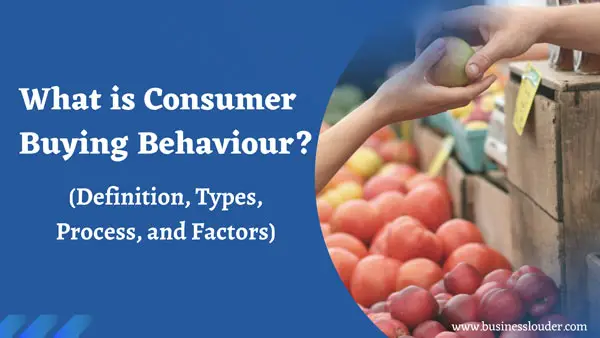If you’re a marketing enthusiast looking to improve your strategies or curious to understand your own buying habits, join us as we explore the interesting science behind the choices we make when selecting a product or service over another.

Here in this blog post, we have discussed consumer buying behavior and its definition, types, processes, and factors that influence consumers purchasing decisions. Let’s first understand what is consumer buying behavior.
What is Consumer Buying Behaviour?
Consumer Buying Behavior typically refers to the actions and decisions taken by consumers before buying a service or product. It is the buying behavior of potential customers before, during, and post purchasing the product or service.
Many sociological, psychological, and cultural elements, as well as the influence of social media posts, play a role in how potential customers engage with the market.
Consumer Buying Behavior is also called ‘Consumer Buying Decision’. Understanding consumer buying behavior is a vital element of any marketing strategy.
Types of Consumer Buying Decisions
We will be discussing the 4 most common types of Consumer Buying Decisions.
1. Complex Buying Decision
This type of decision is caused when consumers are purchasing an expensive, and/or infrequently bought product. In this infrequent transaction, consumers are highly involved in a purchase decision consisting of thorough research before committing to the high-value investment.
For example – Buying an unfamiliar or high-risk product, such as a house or car.
2. Dissonance-reducing Buying Decision
This type of consumer buying decision takes place when consumers make expensive or risky purchases and later feel confused or uncomfortable about their decision. In this type, the buyer involvement is very high. Low availability of choices, that too with high prices and infrequent purchases creates ‘Dissonance’ among consumers.
Consumers are ultimately forced to buy goods that don’t have many choices and are thus left with limited decision-making.
For example – Buying an uncommon product such as a lawnmower or collapsible table.
3. Habitual Buying Decision
When consumers are buying products for their everyday use, they have little involvement in the brand category or product. This minimal decision-making and informational search or marketing efforts is based on prior experience of purchase of the product. This is known as a Habitual Buying Decision or ‘Routine Purchase Decision’.
For example – Buying the regular and preferred type of bread.
4. Variety-seeking Decision
In this type of Decision-making, consumer involvement is low. Consumers decide to purchase different products not because of dissatisfaction of the previous product, but due to an urge to seek variety. In this case, the cost of switching products is quite low.
For example – Trying out new varieties of shower gel scents.
Consumer Buying Process in Marketing
The Consumer Buying Process is a multi-stage process that involves identifying the problems, collecting data, exploring the options available, making a decision to purchase, and evaluating the experience afterward.
Consumers may be affected at any time during these stages due to personal views and values, marketing campaigns, product features, social conventions, and environmental conditions.
The 5 stages of the Consumer Buying Process in Marketing is as follows:
1. Identifying a Problem
First and foremost, the consumer notices that they have a problem that needs to be solved. The consumer’s want or desire may be initiated by advertisements or publicity of the products or services, by his/her self-problem, or by the influence of others.
2. Collecting Data
Next, the consumer gathers information or figures out how to fix their problem. He/She might turn to the internet for recommendations, or contact friends, associates, etc. The consumer also collects relevant data by his/her own past experience or knowledge about a particular product.
3. Alternative Decisions
Once the buyer has finished gathering information, he/she will compare, analyze, and evaluate the available alternatives to choose the best possible product.
Here, the consumer may focus on attributes such as products’ brand, prices, quality, features, warranties, performance, etc. He/She may also look at others’ reviews to help them decide.
4. Purchase Decision
Purchase decision means selecting the best option from among all the available alternatives. This is the stage where consumers will make a decision about their purchase and spend money on a solution to their problem.
5. Post-Purchase Decision
This is the last step in the consumer buying process. It is in step that the customer, after purchasing the particular product, will determine whether to make a repurchase or not. A satisfied consumer will not only make repurchases but will also motivate other potential customers to buy the same product.
On the other hand, a dissatisfied customer will not only cancel a new purchase decision but also discourage other potential buyers of that product and damage the goodwill of the firm.
Factors Influencing Consumer Buying Behavior
Consumer Buying Behavior is influenced by various external factors and internal factors. Let’s take a look at these:
1. Psychological Factors
The various psychological matters of the consumers such as their ability to understand information, mindset, perception of needs, personal beliefs, and attitudes will determine how they feel about not only the product and the brand but also the marketing campaign.
2. Economic Factors
The income level or economic level largely affects the buying behavior of consumers. The higher the economic level, the higher will be the purchasing power of the consumer. The family income of the consumer also affects his buying behavior.
3. Personal Factors
These factors include demographic factors such as gender, age, occupation, marital status, education, personal beliefs, morals and values, etc. In industries like food and fashion, personal factors play an extremely significant role.
To better understand consumers, businesses need to look closely at their lifestyles – daily routines, leisure activities, etc.
4. Socio-Cultural Factors
It depends on the consumer and his family, values, level of education, society’s beliefs, people living in the society, social network, social class, religious and ethnic background, and so on.
Different cultures with different customs and rituals also influence what types of products people purchase. Consumers from the same social class generally exhibit similar buying behavior.
5. Situational Factors
These are temporary in nature and include physical factors – layout of the store, store’s location, music and lighting of the store, etc. Businesses try to create situational factors as favorable as possible.
Other situational factors may also include holidays and the moods of the consumer.
6. Marketing Campaigns
Marketing campaigns, if done regularly and with the right marketing message, can influence consumer buying behavior. They can even persuade consumers to opt for more expensive alternatives or change brands altogether.
A good marketing message can influence impulsive purchases.
7. Group Influence
Peer pressure – such as family members, classmates, neighbors, and acquaintances, also influences consumer buying behavior.
The Final Word
In today’s age of marketing, consumer behavior towards the business’s services and products has a significant effect on its performance.
A deeper knowledge of target consumer purchasing decisions and patterns enables businesses to tailor their marketing strategies ultimately leading to greater customer satisfaction, boosting revenue ultimately increasing profits, and also providing greater sustainability.
We hope you have found this guide helpful in understanding the concept of consumer buying behavior and its types, processes, and factors.



Hello just wanted to give you a brief heads up and let you know a few of the images aren’t loading correctly. I’m not sure why but I think its a linking issue. I’ve tried it in two different internet browsers and both show the same results. http://www.hairstylesvip.com